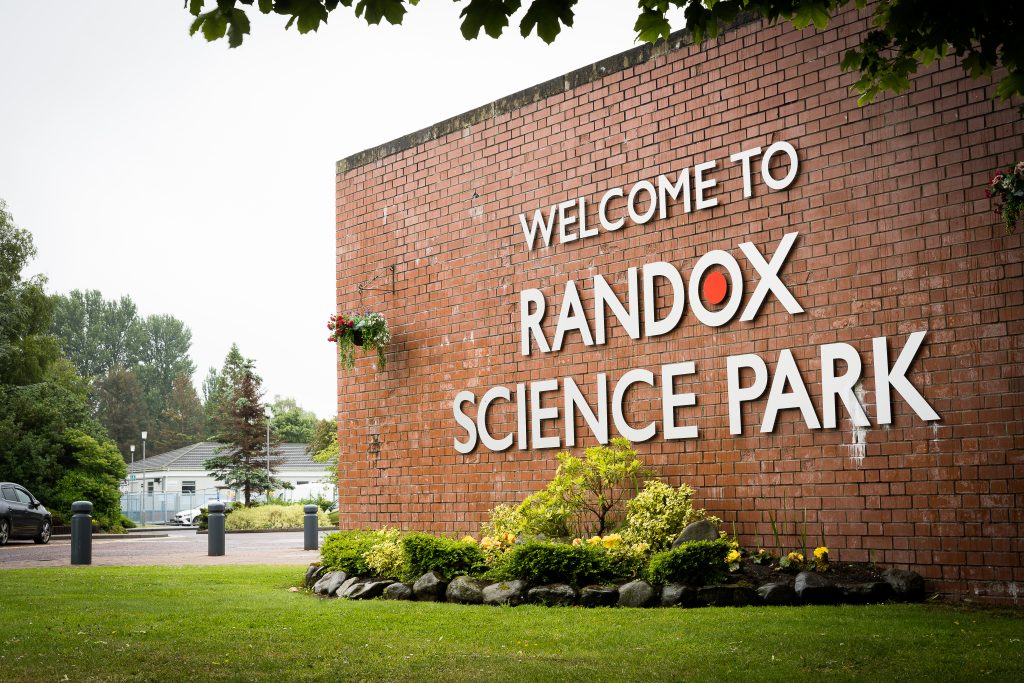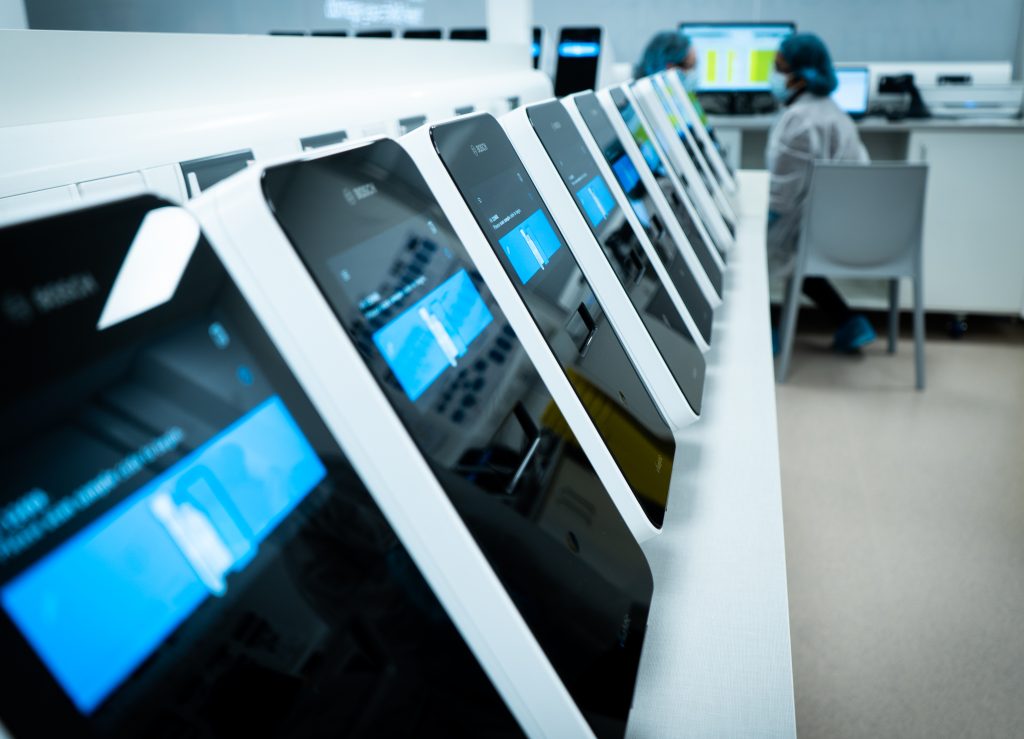Randox Clinical Laboratory Services
Randox Clinical Laboratory Services (RCLS) specialises in offering esoteric biomarker testing utilising the expertise and knowledge Randox has built over 40 years producing high quality IVD diagnostics. RCLS strives to provide a clinical laboratory service to meet the time sensitive, bespoke requirements of research and clinical trial projects globally.
By utilising Randox Clinical Laboratory Services you can save your laboratory time and money. Our multiplex panels offer a cost effective, labour saving and time reducing solution for your sample testing. As a result, we provide your laboratory with the best solution for your sample testing.
Clinical laboratories traditionally perform diagnostic testing from a variety of patient samples (whole blood, serum, plasma, saliva, sputum, CSF, swab collections) to determine their health status.
In addition to Diagnostics, Randox Laboratories also perform Biomarker analysis from selected patient cohorts in support of pharma research, aiming at discovering a biological signal related to an NDE’s activity (targeted Biomarker approach) or a novel druggable target (proteomic analysis). Randox Biosciences offer multiple technical solutions to address the above, mostly based on the Randox proprietary Biochip Array Technology.
Why RCLS?


Sample and Data Management
- LIMS system (Labware) utilised and connected throughout the lab
- Customer and project specific folders on an internal secure server
- Ability to transfer data securely through secure email/drop box
Capabilities
Randox Biosciences provide the building blocks of diagnostic development which includes antibodies, corresponding conjugates and proteins. Our immunoassay product offering provides diagnostic solutions covering a variety of disease areas including thyroid, reproduction, cardiovascular and renal.
Biochip Technology from Randox is an innovative assay technology which utilises multiplex testing methodology in a rapid, accurate and easy-to-use format, catering both molecular and immunoassay testing. The technology works by combining a panel of related assays in a single biochip with a single set of reagents, controls and calibrators. Only one single undivided sample is used. The results are read by a CCD-camera and custom image-processing software.
Custom Assay Development
Serving the diagnostic, pharmaceutical, contract research and biotech industries, Randox Biosciences dedicated custom unit develops and manufactures custom assay solutions. This also includes full customised quality control sera and calibrators. A selection of over 320 pre-qualified biomarkers is available for a custom panel design. However, any specific biomarker of interest will be considered for integration into an existing or desired panel, for technical feasibility (concentration range compatibility, potential interferences/cross-reactivities). The number of the required novel biomarkers will help make the feasibility study as a pertinent and complete as possible.
Companion Diagnostics (CDx) are part of the services that Randox Biosciences supply to pharmaceutical companies. With a long-recognized expertise in the development of esoteric assays, and more than 500 IVD products available globally, Randox is a partner of choice to support your CDx needs.
Full Assay Menu
| Acute Kidney Injury | |||
| Clusterin | Cystatin C | Kidney Injury Molecule-I | Lipocalin |
| Adhesion Molecules | |||
| E-Selectin | Intercellular Adhesion Molecule-I | L-selectin | P-selectin |
| Vascular Cell Adhesion Molecule-I | |||
| Anaemia | |||
| Ferritin | |||
| Alzheimers Risk | |||
| ApoE4 | Pan ApoE | ||
| Cerebral | |||
| D-Dimer | Neuron Specific Enolase | Neutrophil Gelatinase-Associated Lipocalin | Soluble Tumour Necrosis Factor Receptor I |
| Chronic Kidney Disease | |||
| C3a Des Arg | C-Reactive Protein | Cystatin C | D-Dimer |
| Epidermal Growth Factor | Fatty Acid-Binding Protein I | Interlukin-8 | Macrophage Inflammatory Protein-1α |
| Neutrophil Gelatinase-Associated Lipocalin | Soluble Tumour Necrosis Factor Receptor I | Soluble Tumour Necrosis Factor Receptor II | |
| Covid-19 | |||
| SARS-CoV-2 Antigen | Receptor Binding Domain | Nucleocapsid | |
| Cytokines | |||
| Granulocyte-Macrophage Colony Stimulating Factor | Interleukin-1α | Interleukin-1ϐ | Interleukin - 2 |
| Interleukin - 3 | Interleukin - 4 | Interleukin - 5 | Interleukin - 6 |
| Interleukin - 7 | Interleukin - 8 | Interleukin - 10 | Interleukin - 12p70 |
| Interleukin - 13 | Interleukin - 15 | Interleukin - 23 | Interferon Gamma |
| Human EGF | Monocyte Chemotactic Protein | Macrophage Inflammatory Protein-1α | Matrix Metalloproteinase-9 |
| Soluble IL-2 Receptor α | Soluble IL-6 Receptor | Soluble Tumour Necrosis Factor Receptor I | Soluble Tumour Necrosis Factor Receptor II |
| Tumour Necrosis Factor Alpha | Vascular Endothelial Growth Factor |
| Epidermal Growth Factor (EGF) | |||
| Amphiregulin (AREG) | Herapin-Binding EGF-like Growth Factor (HBEGF) | Transforming Growth Factor - Alpha (TGF-α) | |
| Gastrointestinal | |||
| Gastrin 17 | Helicobacter Pylori | Pepsinogen I | Pepsinogen II |
| Immunodeficiency | |||
| Interleukin - 17A | Interleukin - 17F | Interleukin - 22 | Interleukin - 17 |
| Metabolic | |||
| Ferritin | Interleukin - 6 | Insulin | Adiponectin |
| C-Reactive Protein | Cystatin C | Leptin | Parathyroid Hormone |
| Plasminogen Activator Inhibitor-I | PTH | Resistin | Tumour Necrosis Factor α |
| Pancreatic Cancer | |||
| Cancer Antigen 19-9 - CA19-9 | Carcinoembryonic Antigen | Alpha-I-Acid Glycoprotein | |
| Stroke | |||
| Brain-Derived Neurotrophic Factor - BDNF | D-Dimer | Glial Fibrillary Acidic Protein - GFAP | Glutathione S - Transferase Pi - GSTPi |
| Heart-Type Fatty Acid-Binding Protein - FABP3 | Interleukin-6 - IL-6 | Nucleoside Diphosphate Kinase - NDKA | Neuron Specific Enolase - NSE |
| Parkinson Protein 7 - PARK-7 | Soluble Tumour Necrosis Factor Receptor I - sTNFRI |
| Thyroid | |||
| Anti-Thyroglobulin (TgAb) | Anti-Thyroid Peroxidase Antibody (TPOAb) | Thyroxine Binding Globulin (TBG) | Total Thyroxine (TT4) |
| Total Tri-Iodothyronine (TT3) | |||
| Tissue Damage | |||
| Adipose Fatty Acid Binding Protein - FABP4 | Brain Fatty Acid Binding Protein - FABP7 | Epidermal Fatty Acid Binding Protein - FABP5 | Heart-Type Fatty Acid-Binding Protein - FABP3 |
| Ileal Fatty Acid Binding Protein - FABP6 | Liver Fatty Acid Binding Protein-I - FABPI | Testis Fatty Acid Binding Protein - FABP9 |
| CARDIAC RISK PREDICTION | |||
| Target | SNP | Target | SNP |
| MIA3* | rs17465637 | LPA* | rs3798220 |
| 9p21 | rs10757274 | LPA* | rs10455872 |
| DAB2IP | rs7025486 | MRAS* | rs9818870 |
| CXCL12 | rs1746048 | LPL* | rs328 |
| ACE | rs4341 | LPL | rs1801177 |
| NOS3 | rs1799983 | SORT1*+ | rs646776+ |
| APOA5 | rs662799 | PCSK9 | rs11591147 |
| SMAD3 | rs17228212 | APOE* | rs429358 |
| APOB* | rs1042031 | APOE* | rs7412 |
| CETP | rs708272 | ||
| CHRONIC LUNG DISEASE (CLD) ARRAY | |||
| Viral | |||
| Adenovirus | Metapneumovirus | Respiratory syncytial virus A | Respiratory syncytial virus B |
| Rhinovirus A/B/C | Influenza virus A | Influenza virus B | |
| Bacterial | |||
| Achromobacter xylosoxidans | Bordetella pertussis | Burkholderia cepacia complex (21spp) | Burkholderia cenocepacia |
| Chlamydia pneumoniae | Haemophilus influenza | Moraxella catarrhalis | Mycoplasma pneumoniae |
| Non-tuberculous mycobacterium (15 spp) | Mycobacterium avium complex (4 spp) | Pandoraea species (5 spp) | Prevotella species (16 spp) |
| Pseudomonas aeruginosa | Staphylococcus aureus | Stenotrophomonas maltophilia | Streptococcus pneumoniae (21 spp) |
| Streptococcus species (19 spp) | Veillonella species (3 spp) | ||
| Fungal | |||
| Aspergillus fumigatus | Candida albicans | Exophialia dermatitidis | Scedosporium species (7 spp) |
| Antibiotic Resistance Markers | |||
| mecA (incl MRSA) |
| FAMILIAL HYPERCHOLESTEROLEMIA | |||
| LDLR 38 mutations | APOB 1 mutation | PCSK9 1 mutation | |
| APOB | PCSK9 | ||
| Mutation | Protein | Mutation | Protein |
| c.10580G>A | p.(Arg3527Gln) | c.1120G>T | p.(Asp374Tyr) |
| LDR | |||
| Mutation | Protein | Mutation | Protein |
| c.2292delA | p.(Ile764Metfs*2) | c.1187-10G>A | p.(=) |
| c.1444G>A | p.(Asp482Asn) | c.1048C>T | p.(Arg350*) |
| c.551G>A | p.(Cys184Tyr) | c.118delA | p.(Ile40Serfs*166) |
| c.1845+11C>G | p.(=) | c.1168A>T | p.(Lys390*) |
| c.693C>A | p.(Cys231*) | c.232C>T | p.(Arg78Cys) |
| c.933delA | p.(Glu312Serfs*58) | c.1587-1G>A | p.(=) |
| c.301G>A | p.(Glu101Lys) | c.1706-10G>A | p.(=) |
| c.313+1G>A | p.(=) | c.1796T>C | p.(Leu599Ser) |
| c.1706-1G>A | p.(=) | c.1436T>C | p.(Leu479Pro) |
| c.1706-1G>A | p.(Cys677Arg) | c.1474G>A | p.(Asp492Asn) |
| c.2029T>C | p.(Pro685Leu) | c.501C>A | p.(Cys167*) |
| c.2054C>T | p.(Trp483Arg) | c.662A>G | p.(Asp221Giy) |
| c.1447T>C | p.(Gly478Arg) | c.682G>T | p.(Glu228*) |
| c.1447T>C | p.(Asp72Thrfs*134) | c.1150C>T | p.(Gln384*) |
| c.214delG | p.(Trp87Gly) | c.938G>A | p.(Cys313Tyr) |
| c.259T>G | p.(Arg633Cys) | c.136T>G | p.(Cys46Gly) |
| c.1897C>T | p.(Asp227Glu) | c.2042G>C | p.(Cys681Ser) |
| c.681C>G | p.(Asn688Glnfs*29) | c.1618G>A | p.(Ala540Thr) |
| c.1285G>A | p.(Val429Met) | c.680_681delAC | p.(Asp227Glyfs*12) |
| KRAS, BRAF, PIK3CA ARRAY | |||
| KRAS Gene Targets | |||
| G12A | G12R | G12D | G12C |
| G12S | G12V | G13D | G13C |
| G13R | Q61K | Q61L | Q61R |
| Q61H(1) | Q61H(2) | A146T | A146P |
| BRAF Gene Targets | |||
| V600EG12R | |||
| PIK3CA Gene Targets | |||
| E542K | E545K | H1047R | |
| RESPIRATORY MULTIPLEX ARRAY II | |||
| Viral | |||
| Influenza A | Influenza B | Adenovirus A/B/C/D/E | Bocavirus 1/2/3 |
| Coronavirus 229E/NL63 | Coronavirus OC43/HKUI | Enterovirus A/B/C | Metapneumovirus |
| Parainfluenza virus 1 | Parainfluenza virus 2 | Parainfluenza virus 3 | Parainfluenza virus 4 |
| Respiratory syncytial virus A/B | Rhinovirus A/B/C | ||
| Bacterial | |||
| Legionella pneumophila | Bordetella pertussis | Chlamydophila pneumoniae | Haemophilus influenzae |
| Moraxella catarrhalis | Mycoplasma pneumoniae | Streptococcus pneumoniae |
| SEXUALLY TRANSMITTED INFECTION (STI) ARRAY | |||
| Pathogens | |||
| Chlamydia trachomatis (CT) | Neisseria gonorrhoea (NG) | Trichomonas vanginalis (TV) | Mycoplasma genitalium (MG) |
| Treponema pallidum (Syphilis) (TP) | Herpes simplex virus 1 (HSV-1) | Herpes simplex virus 2 (HSV-2) | Haemophilus ducreyi (HD) |
| Mycoplasma hominis (MH) | Ureaplasma urealyticum (UU) | ||
| URINARY TRACT INFECTION (UTI) ARRAY | |||
| Bacterial | |||
| Acinetobacter baumannii | Citrobacter freundii | Citrobacter koseri | Klebsiella aerogenes |
| Enterobacter cloacae | Enterococcus faecalis | Enterococcus faecium | Escherichia coli |
| Klebsiella oxytoca | Klebsiella pneumoniae | Morganella morganii | Proteus spp. |
| Pseudomonas aeruginosa | Providencia rettgeri | Providencia stuartii | Serratia marcescens |
| Staphylococcus aureus | Staphylococcus epidermidis | Staphylococcus saprophyticus | Streptococcus agalactiae (GBS) |
| Fungal | |||
| Candida albicans | |||
| Antibiotic Resistance Markers | |||
| mecA (incl MRSA) | Trimethoprim Resistance 1 | Trimethoprim Resistance 2 | Trimethoprim Resistance 3 |
| S mecA (incl MRSA) | Trimethoprim Resistance 4 | Trimethoprim Resistance 5 | Van A (Vancomycin Resistance A) |
| Van B (Vancomycin Resistance B) |
